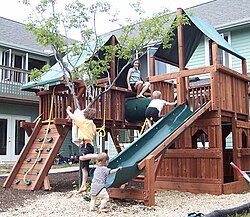
Back سكن مشترك Arabic Cohabitatge Catalan Cohousing Czech Bofællesskab Danish Cohousing German Covivienda Spanish Yhteisöasuminen Finnish Cohabitat French Covivenda Galician सह-आवास Hindi

Cohousing is an intentional,[1] self-governing,[2] cooperative community where residents live in private homes often clustered around shared space.[3] The term originated in Denmark in the late 1960s.[4] Families live in attached or single-family homes with traditional amenities, usually including a private kitchenette. As part of the communal orientation, shared spaces typically feature a common house, which may include a large kitchen and dining area, laundry, and recreational spaces. Walkways, open space, parking, playgrounds and gardens are common examples of shared outdoor spaces designed to promote social interactions. Neighbors also often share resources like tools, babysitting and creative skills.
Neighbors collaboratively plan and manage community activities and shared spaces while maintaining their own income and private lives.[5] The legal structure is typically a homeowner association or housing cooperative,[6] and some use community land trusts.[7] To promote the common good, cohousing members regularly share meals, attend meetings, and participate in community work days.[8] As part of cohousing's social nature, neighbors gather for parties, games, gardening, musical performances, movies, sports, and celebrations. Living in cohousing makes it easy for residents to form clubs, organize child and elder care, share information, free cycle and carpool.[9]
Cohousing facilitates interaction among neighbors and thereby provides social, practical, economic, and environmental benefits.[10][11] With democracy in action in their cohousing community, residents also tend to be more active in civic[12] affairs in the broader community.
- ^ Albright, Ty (15 March 2017). "More than Cohousing – Cohousing Like and other Alternative Housing Solutions – what's the difference?". cohousing.org. Retrieved 5 July 2024.
- ^ DePaulo, Bella (13 August 2013). "What Does a Cohousing Community Look Like?". belladepaulo.com. Retrieved 5 July 2024.
- ^ Cohousing definition Archived 16 April 2009 at the Wayback Machine (American Heritage Dictionary of the English Language: Fourth Edition. Houghton Mifflin 2000).
- ^ Caves, R. W. (2004). Encyclopedia of the City. Routledge. p. 119.
- ^ "About [LA Ecovillage]". laecovillage.org. Retrieved 1 July 2024.
- ^ REBAC Staff (31 December 2018). "Cohousing: Private Homes With Community Living". homebuying.realtor.com. Retrieved 30 June 2024.
- ^ "Land Trusts: Affordable, Cooperative and Restorative". planning,org. 14 April 2019. Retrieved 30 June 2024.
- ^ Senior Cohousing Advocates Committee (28 September 2023). "Managing participation in Community". cohousing.org. Retrieved 30 June 2024.
- ^ "Cherry Hill Cohousing: What is Cohousing?". wen.cohousing.com. Retrieved 7 July 2024.
- ^ McCamant, Kathryn; Durrett, Charles. "Cohousing: A Contemporary Approach to Housing Ourselves." Berkeley, Ca.: Ten Speed Press, 1994.
- ^ Durrett, Charles. "Senior Cohousing: A Community Approach to Independent Living." Gabriola Island, B.C.: New Society Publishers, 2009.
- ^ Berggren, Heidi. "Cohousing as Civic Society: Cohousing Involvement and Political Participation in the United States∗" (PDF). UMass.edu. umassdartmouth. Retrieved 30 June 2024.